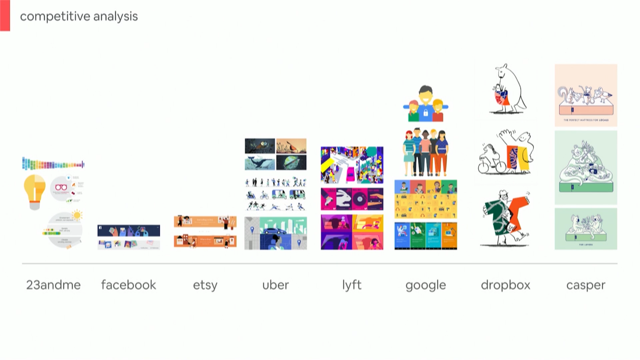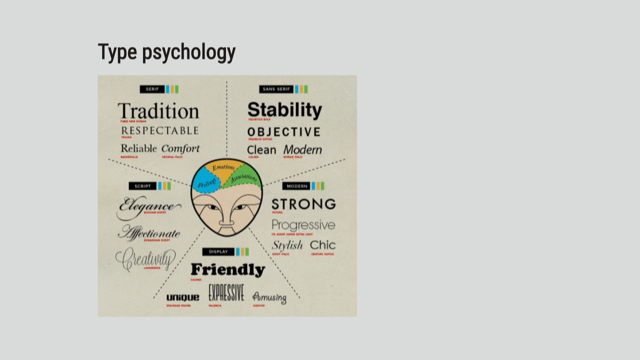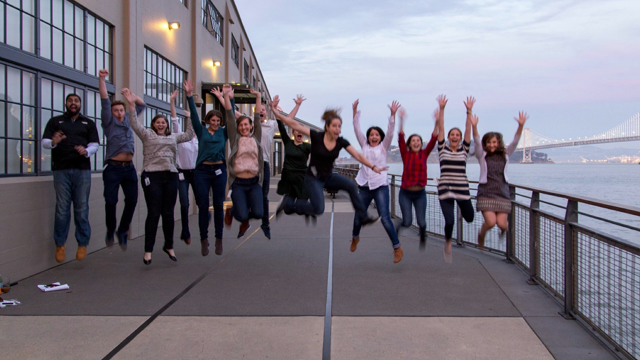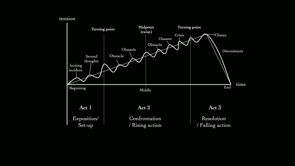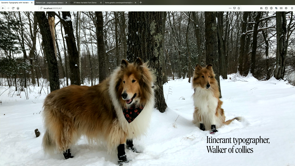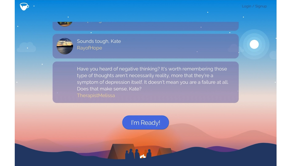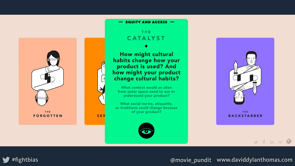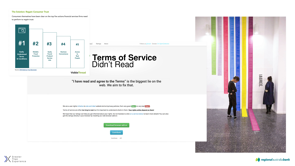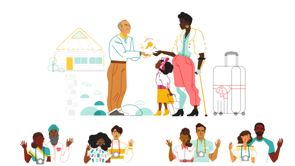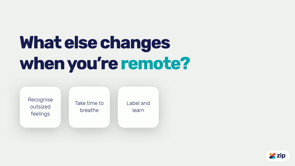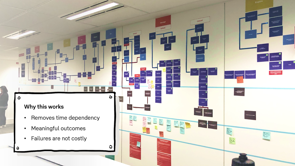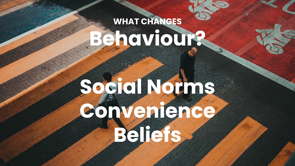
(upbeat music) - Hi everyone.
I'm Randy, the Head of Design at Grab.
- Hi, I'm Preeti, I'm the Behavioural Science Lead at Grab. Grab is Southeast Asia's Superapp.
It does everything from rid- hailing to food delivery, to express delivery, and we'll kinda do a lot more.
- So when we think about design, we're often thinking about either the output of design or the process of design.
We say, design is these artefacts or design of these methods.
But what really do we create? What is the output of the design itself? Is it diagrams and workflows that tell us how to sequence a series of events? How we intend for a piece of software to work? Is design a set of personas about our customers or users, so we can understand them, build empathy for them and help others understand those customers as we make things? Or design is the pixels and the animations that create the UI that we ship into a piece of software that the customer sees.
So of course, design is all those things, It could be all these things.
But we've been thinking about design as this process of creating change.
And that change is either a change in perception, a change in behaviour or both.
- What actually does change perception? There's a lot of things that go into perception. So let's look at some examples of these that actually change perception.
So you walk into a supermarket and you buy a banana. What's the difference between that and 42 bananas (indistinct) which is taped to the wall and sold for $120,000 and all of these...
It seems like a lot of difference comes just because of the way and the place where the banana has actually been put which means that one of the things that actually changes perception is the context and the situation around that.
What changes perception? - First we have context, the situation around (indistinct) - What else changes perception? Let's take a look and observe an example.
Here, we have two kinds of pens.
The thing is you can write with both of them but one of them is the most expensive pen in the world which cost a fortune to buy and the other one sells at 50 pens for $10. And what's the difference? It's actually just the brand.
So, what's the other thing that changes perception? - The brand changes your perception, association, the values you associate with the name or the feeling, fuzzy idea you have that surrounds that particular object or experience.
- Exactly, here's another interesting story. Have you ever walked by a restaurant and walked in to the restaurant Just because it had a lot people sitting in it and then you discard it because there's nobody sitting in there? The reason why we do that is because, if there's a longer queue we just assume that the restaurants will be good. So way back in the 1950s, when we didn't have review websites and you didn't know what was actually good and you walked onto Broadway to pick a show to buy tickets for.
The only way to know if the show was good was actually by seeing how long the queue was. There was one guy who was really famous for doing something very peculiar.
So Mike Todd was a producer on the Broadway and he knew this fact.
He knew that people would look at a queue and pick the show based on that.
Very smartly, he employed an 80 year old lady with arthritis to give out tickets on his ticket counter, which means that by default, the queue would be long because she was so slow at giving out tickets. Because the queue was long, people would assume it's a good show and they'll actually walk in there, which means that one insight for us is that people do form perceptions based on what they see others doing.
Closer to our time, we've all seen this in the last few months where there was panic buying of toilet rolls. Although there wasn't actually a shortage of it but people were buying it because they saw empty shelves in supermarkets. And their assumption is, "If everyone's buying it "It must be something valuable." Which means that one thing that actually changes perception is- - Social Norms.
If you see other people doing something, then it changes how you think about it, and you may do it too.
- Exactly.
We've looked at one part of this.
This was all about perception.
What about behaviour? What actually changes behaviour? This was an interesting story that we read about, which we thought actually tells a lot about how people change their behaviour.
Somewhere in the U.K., there's a little candy store where kids come and buy candy after school everyday.
But one problem is that any time they buy candy they throw the litter on the road right outside the shop.
The shopkeeper kept telling people not to do that but the kids would not listen.
They will not change their behaviour.
Finally, one day he did something really smart. Every time he would hand on a candy to a kid he would write their name on the wrapper.
So now if you're littering, everybody knows that Tom threw this or John threw this, and now suddenly kids stopped littering because they cared about what other people think. They don't want others to know that they're actually littering.
One thing that actually changed their behaviour was knowing what other people think about them, which means that one thing that changes behaviour is another kind of Social norms.
- So, social norms, if we care about what someone thinks of us, we will shift our behaviour and it can be a powerful tool If we think about changing behaviour in the context of a designed experience.
Also, you probably shouldn't throw out your Starbucks cups. - Exactly.
This is a pretty popular example shown all over the Science Lead Lab Grab where Homer Simpson was known to love donut actually baked fruits.
The only reason he does that is because fruits are more readily available to buying donuts which are way back in the shelf somewhere up there.
And, if you think about it, this is something that all of us do in supermarkets. When you walk in, the snacks are always at eye level and they're so easily accessible that you always end up buying a lot of them. A lot of times we actually end up doing something just because it's the more convenient thing to do. - If you think about what shaping behaviour, talking about Social Norms and then convenience, what is easy to do.
You could map this quite easily to things like the first result in a search or even setting defaults and what makes the behaviour you attend so easy to do that people (mumbles) - Then there are some behaviours we do because they're actually the right thing to do, we actually believe in something.
A lot of environmentally conscious behaviours happen because people genuinely care about the cause and they actually think that this is the right thing to do. Which means that although rare, in some cases, behaviour changes exactly happens because people believe that that's the right thing to do. - So we have Social Norms Convenience, and then beliefs, doing something because you believe it's the right thing to do and that changing your behaviour.
We've looked at perception and behaviour separately. what changes, perception and behaviour? If we think about design as the output or the output of design being this change we create. What are examples of things that we address both? We're gonna take this into some examples inside Grab, and illustrate for you a few of these concepts of work. In designing we think about this Venn diagram between the perception side.
What can I use to change the perception and the direction Of the behaviour change that we want to create? In complimentary, how can I bring about a behaviour change using design while building on that perception that someone already has, or the perception we've created through some of these other mechanisms.
So let's take a few of these examples from Grab. If it's late at night and you're looking for a ride, I'm sure you've all probably experienced something whether it's traditional taxi cabs or ride-hailing or otherwise where it can be really difficult to find a ride because a lot of people want a ride and there aren't many drivers around.
And so that can create a supply demand mismatch which means the price goes up.
Of course, people don't like that the price goes up and, or they don't like that they have to wait a long time. So how do we overcome something like this changing perception of behaviour using context? - This is actually an example of something that we've heard a lot of passengers talk about, and this is especially worse when you are standing at the airport at one o'clock and you're already had a long flight and you're trying to get back home.
When you see that surge price, the first reaction that customers have, the perception they have, is that, "These guys are trying to fleece me. "Who's even riding so late in the night? "why are they charging me so much? "There's nobody around.
"Why am I having to pay so much?" The problem with that is that the behaviour is that they still end up booking the ride, but they're feeling very bad about it.
They feel they've booked it because they didn't have an option and that somebody is actually trying to cheat them on this. So one of the things we realised when we were doing this research was that people don't know what's actually happening around them, they don't have the context to this.
So that's what we decided to do.
We decided to show customers context through design in our app.
Now, instead of showing just a surge price we added a statement there that actually tells them what's happening on ground which is that Batman drivers are on the way that's because the few drivers who're are actually out there on the road at 1 a.m. in the night are actually superheroes.
They're the guys who are actually helping you get home when there's no one else around. That's why we decided to show it.
That causes a change in perception because now suddenly you're looking at drivers as saviours, as people who are out there helping you out in the middle of the night.
Because of that, you're still booking a ride but you're actually thankful for the fact that you're getting a rid at this time of the night. Just by adding that small bit of context, we help change the perception as well as the behaviour of passengers.
- That's a really powerful example and thinking really how simple the Interventions are as well, really a simple content design moment and easily testable, easy to experiment.
- We actually added a lot of different contexts Like the Batman drivers was one example, but then similar to that we made it an interface which could add any kind of context.
So if it is surging at a stadium because the match is called over, we can actually add that as a context so that people know what's actually happening around them. - So we'll look at our next example, using Social Norms mechanism which is bringing down cancellations.
Similarly, if a person is ordering food or booking a ride, they might have certain expectations about how quickly it could come.
Maybe how far away a driver is.
There's a number of reasons why a person might choose to cancel that ride or that order when they're somewhere in the process. Of course we don't want to reduce the number of cancellations for a variety of reasons.
Here's an example of where we applied Social norms and another simple intervention, to really produce important changes.
- This is also an interesting insight for us. When we started talking to passengers who were cancelling a lot, what are the things that came out was the fact that they thought everybody cancels because they don't know what's actually happening around, their assumption is that, "I've been cancelling a lot "and I'm sure everybody cancels." They actually don't know what the others are doing. Even though there was a fine for it, they'll absolutely comfortable pay the fine, as long as they were getting some kind of leeway in cancelling and keeping their schedule a little bit flexible. We realised that the problem was that we needed to change the perception and that would actually lead to the behaviour change. So we did a very small intervention.
We just send out an SMS, a message that told the passenger that he was in the top 1% of people who had the highest cancellation data.
Now, suddenly he knows that everybody's not cancelling. So the perception changed.
"Everyone's cancelling rides and orders.
"I'm actually a minority of people "who've shown this behaviour "and I don't wanna stand out.
"I'll stop cancelling." So that leads to the behaviour change.
- Let's look at one more example.
In this case, and you can see there's a theme, where a lot of these challenges relate to the relationship between the supply side of the marketplace and the demand side of the marketplace.
How many drivers are available, where they are, what are the prices.
Because of that, availability at the time of day. In this case, we're looking at how do we shape driver's behaviour? Drivers want to get more jobs and we want to provide those jobs to them where those jobs are, where the highest density of jobs are.
How do we get them to go from where they are to where we want them to be to achieve the thing that we both want (laughs) Here's a look at a case using really transparency of data and information to help guide their behaviour. - One of the things we realised when we spoke to drivers is that a lot of times they actually don't know where to go but they're really good at maps.
They know areas that they've been, they've been around these areas so much that it's like the back of their hand.
They know exactly where they should be going, which means that because they don't know exactly where they should go for more drives, they just follow their instincts a lot of time. That was the perception and behaviour that we needed to change.
Our product which is a heat map actually gives drivers information about demand and it is on a map.
Now it actually puts together the knowledge that they have with data that comes from our system.
Now they know where the demand is and where they should be going.
The perception now changes to, "I don't know where to go "and I need to follow my instincts." It changes to, "Okay, this is the area "that exactly has more demand." And the behaviour now becomes, "I'll follow the map "and I see good." This is actually a good example of how we use tech and design to get people to use, to understand data in an easy way and hence change their perception as well as their behaviour. - That's a really, really strong example.
We go back to this earlier point that when we were designing we're thinking about the intersection between these two areas, perception and behaviour.
We looked at a number of mechanisms that can help us do that.
Social norms, context, brand transparency, convenience and there are many- - There are many more that you can explore this intersection, there's a lot more that can come out of it - We're very excited about this and feel like it's just the beginning, a really exciting set of developments where these two disciplines are blurring in their edges. It's starting to collaborate more together. We're working hard to try to find the opportunities to apply that in our own work and our organisation and we think there's huge potential for other people to look into the intersection between these two and take that with them.
A turn of power and potential.
- Absolutely, very exciting times ahead.
- Thank you all for joining this and (indistinct) - Thank you so much.
